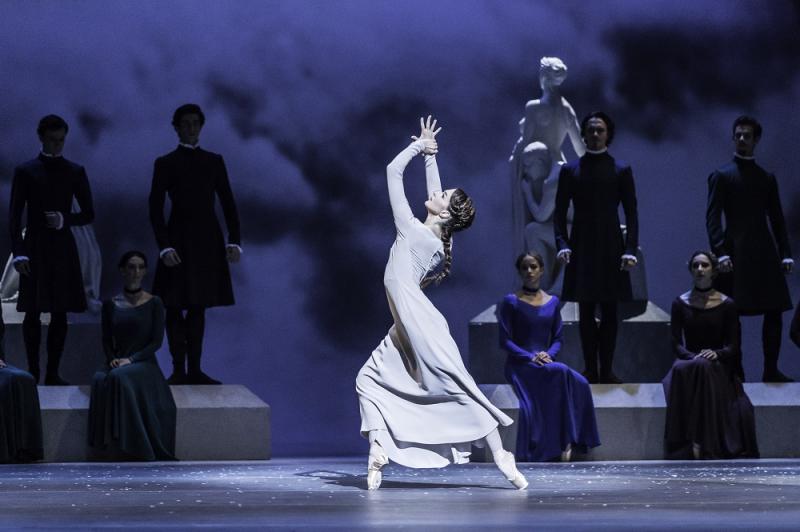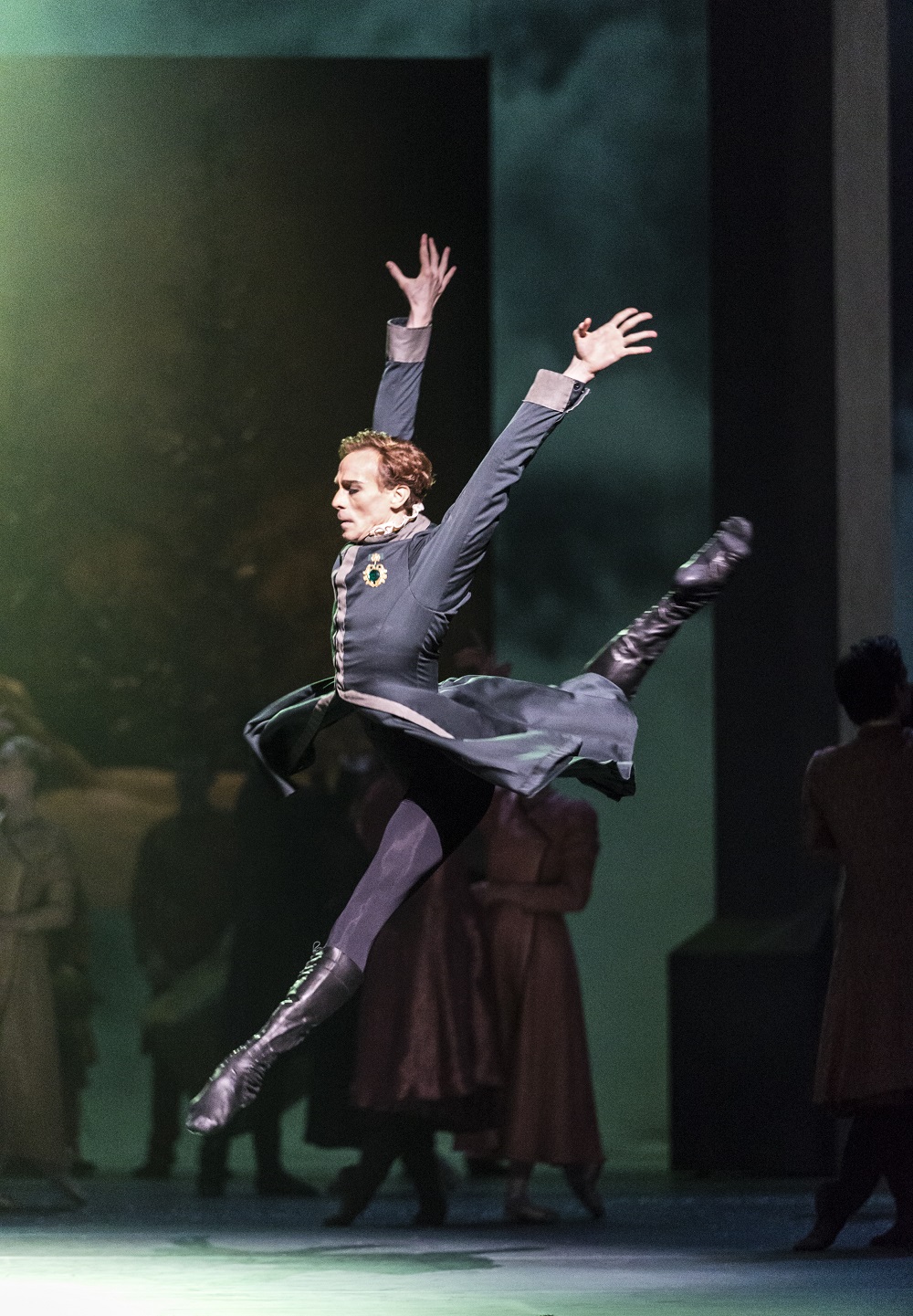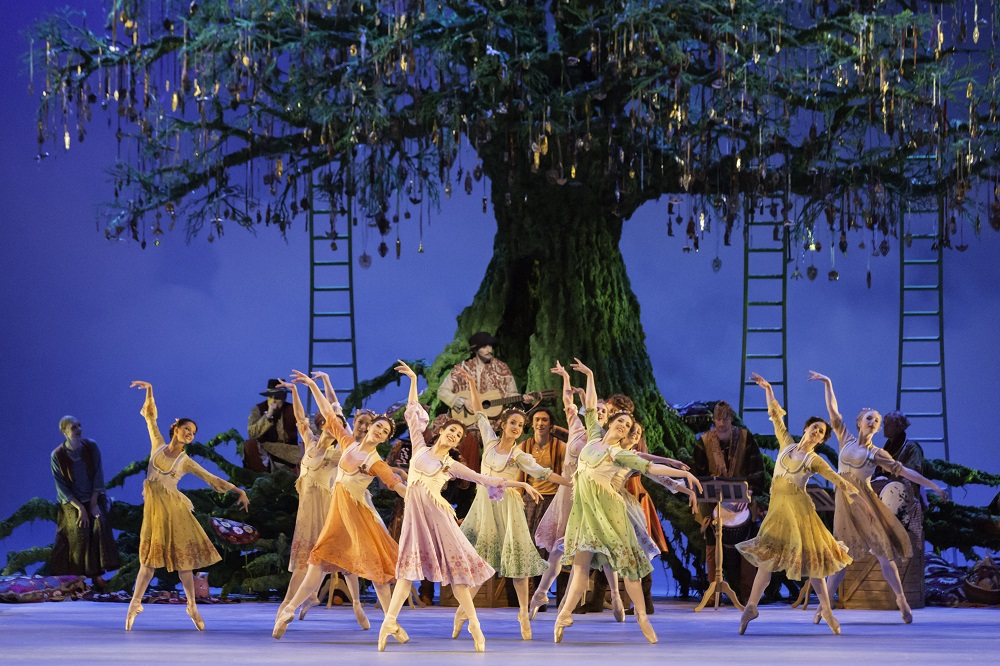The Winter's Tale, Royal Ballet | reviews, news & interviews
The Winter's Tale, Royal Ballet
The Winter's Tale, Royal Ballet
Full Shakespearean breadth, if not depth, in effective revival

It was twelfth night for Christopher Wheeldon's two-year-old, three-act Shakespearean ballet, and this newcomer had one nervous anticipatory question.
Perhaps a play with less magical poetry, like the only-partly-by-Shakespeare Pericles, would have been more friendly to conventional choreography. But in fact this Winter's Tale has a strong balletic structure with its own special flavour: a dark, dramatic first act, the second with its pastoral rebirth coming closest to entertaining divertissement, the last offering the redemption of romance. Two relatively weak finales dominated by clever silk effects and video projections at least have the virtue of symmetry in ship journeys to and from Bohemia.
 Act One belongs to Edward Watson's Leontes (pictured right), with terror in his splayed fingers launching an instant portrayal of mental illness expressed in stylised physicality: more than shades of Mayerling's Crown Prince Rudolf in a character who seems to be on the verge of a Kafka metamorphosis. I well remember Irek Mukhamedov only able to convey the jealousy of Kim Brandstrup's Othello in moments, suggesting that ballet is incapable of fluid psychological development. But the torment of Shakespeare's Leontes is more one-dimensional than that of his Othello, and Watson certainly sustains it.
Act One belongs to Edward Watson's Leontes (pictured right), with terror in his splayed fingers launching an instant portrayal of mental illness expressed in stylised physicality: more than shades of Mayerling's Crown Prince Rudolf in a character who seems to be on the verge of a Kafka metamorphosis. I well remember Irek Mukhamedov only able to convey the jealousy of Kim Brandstrup's Othello in moments, suggesting that ballet is incapable of fluid psychological development. But the torment of Shakespeare's Leontes is more one-dimensional than that of his Othello, and Watson certainly sustains it.
The women also make their mark. Zenaida Yanowsky strikes the right note of authoritative sympathy as nurse Paulina; after the second interval, she dominates both Leontes and the Third Act with the most remarkable gestures of the evening. Lauren Cuthbertson's Hermione only has to mix regal dignity with anguish, but she does it beautifully, the trial scene almost touching depths not reached elsewhere. Sarah Lamb's Perdita in Act Two is her mother's daughter, almost too aristocratic to be taken for a shepherdess; the real fun comes from the Peter Pan of the ballet world Steven McRae as her Florizel, still able in his mid-thirties to project teen spirit. Their various Pas de deux have enough sweet originality to fire up, weaving in and out of ensemble dances (pictured below) which mirror the Balkan influences of the onstage band figuring in all three acts. All five musicians deserve a special credit, absent from the programme.
The sounds of accordion and cimbalom/santoor here are new to the soundworld of Joby Talbot. Otherwise it's familiar from his Alice music, with the same tick-tocking of passing time – or falling snowflakes, perhaps, in this instance – and the darker side of Wonderland kicking off Leontes' pathology. That develops its own identity in the lower brass, superbly counterpointing the women's music in Hermione's chamber, and four chords, half Holst's Uranus, half Messiaen Turangalila stone theme, serve as the only striking leitmotif.
Too often, though, the familiar percussion glitter and tintinnabulations aren't matched by thematic substance. Talbot stands in relation to Prokofiev as Glazunov does to Tchaikovsky, which still isn't bad. There are some bracing changes of metre in the Bohemian act, all of it effective music, but less would sometimes be more, especially so in the final family revelations. Bob Crowley's set, mostly well-lit by Natasha Katz – shame, though, that spotlights are still occasionally in use – is stripped of its columns and Casper David Friedrich canvases to a stark simplicity here which Wheeldon's choreography mirrors in its strangeness. So it's a pity that the score, all of it vividly played by the Royal Opera Orchestra under the admirable David Briskin, should head towards lush overkill. Still, given such high production values, I wouldn't mind seeing a full-length Wheeldon/Talbot Tempest some time in the future.
rating
Share this article
The future of Arts Journalism
You can stop theartsdesk.com closing!
We urgently need financing to survive. Our fundraising drive has thus far raised £49,000 but we need to reach £100,000 or we will be forced to close. Please contribute here: https://gofund.me/c3f6033d
And if you can forward this information to anyone who might assist, we’d be grateful.

Subscribe to theartsdesk.com
Thank you for continuing to read our work on theartsdesk.com. For unlimited access to every article in its entirety, including our archive of more than 15,000 pieces, we're asking for £5 per month or £40 per year. We feel it's a very good deal, and hope you do too.
To take a subscription now simply click here.
And if you're looking for that extra gift for a friend or family member, why not treat them to a theartsdesk.com gift subscription?
more Dance
 'We are bowled over!' Thank you for your messages of love and support
Much-appreciated words of commendation from readers and the cultural community
'We are bowled over!' Thank you for your messages of love and support
Much-appreciated words of commendation from readers and the cultural community
 iD-Reloaded, Cirque Éloize, Marlowe Theatre, Canterbury review - attitude, energy and invention
A riotous blend of urban dance music, hip hop and contemporary circus
iD-Reloaded, Cirque Éloize, Marlowe Theatre, Canterbury review - attitude, energy and invention
A riotous blend of urban dance music, hip hop and contemporary circus
 How to be a Dancer in 72,000 Easy Lessons, Teaċ Daṁsa review - a riveting account of a life in dance
Michael Keegan-Dolan's unique hybrid of physical theatre and comic monologue
How to be a Dancer in 72,000 Easy Lessons, Teaċ Daṁsa review - a riveting account of a life in dance
Michael Keegan-Dolan's unique hybrid of physical theatre and comic monologue
 A Single Man, Linbury Theatre review - an anatomy of melancholy, with breaks in the clouds
Ed Watson and Jonathan Goddard are extraordinary in Jonathan Watkins' dance theatre adaptation of Isherwood's novel
A Single Man, Linbury Theatre review - an anatomy of melancholy, with breaks in the clouds
Ed Watson and Jonathan Goddard are extraordinary in Jonathan Watkins' dance theatre adaptation of Isherwood's novel
 Peaky Blinders: The Redemption of Thomas Shelby, Rambert, Sadler's Wells review - exciting dancing, if you can see it
Six TV series reduced to 100 minutes' dance time doesn't quite compute
Peaky Blinders: The Redemption of Thomas Shelby, Rambert, Sadler's Wells review - exciting dancing, if you can see it
Six TV series reduced to 100 minutes' dance time doesn't quite compute
 Giselle, National Ballet of Japan review - return of a classic, refreshed and impeccably danced
First visit by Miyako Yoshida's company leaves you wanting more
Giselle, National Ballet of Japan review - return of a classic, refreshed and impeccably danced
First visit by Miyako Yoshida's company leaves you wanting more
 Quadrophenia, Sadler's Wells review - missed opportunity to give new stage life to a Who classic
The brilliant cast need a tighter score and a stronger narrative
Quadrophenia, Sadler's Wells review - missed opportunity to give new stage life to a Who classic
The brilliant cast need a tighter score and a stronger narrative
 The Midnight Bell, Sadler's Wells review - a first reprise for one of Matthew Bourne's most compelling shows to date
The after-hours lives of the sad and lonely are drawn with compassion, originality and skill
The Midnight Bell, Sadler's Wells review - a first reprise for one of Matthew Bourne's most compelling shows to date
The after-hours lives of the sad and lonely are drawn with compassion, originality and skill
 Ballet to Broadway: Wheeldon Works, Royal Ballet review - the impressive range and reach of Christopher Wheeldon's craft
The title says it: as dancemaker, as creative magnet, the man clearly works his socks off
Ballet to Broadway: Wheeldon Works, Royal Ballet review - the impressive range and reach of Christopher Wheeldon's craft
The title says it: as dancemaker, as creative magnet, the man clearly works his socks off
 The Forsythe Programme, English National Ballet review - brains, beauty and bravura
Once again the veteran choreographer and maverick William Forsythe raises ENB's game
The Forsythe Programme, English National Ballet review - brains, beauty and bravura
Once again the veteran choreographer and maverick William Forsythe raises ENB's game
 Sad Book, Hackney Empire review - What we feel, what we show, and the many ways we deal with sadness
A book about navigating grief feeds into unusual and compelling dance theatre
Sad Book, Hackney Empire review - What we feel, what we show, and the many ways we deal with sadness
A book about navigating grief feeds into unusual and compelling dance theatre
 Balanchine: Three Signature Works, Royal Ballet review - exuberant, joyful, exhilarating
A triumphant triple bill
Balanchine: Three Signature Works, Royal Ballet review - exuberant, joyful, exhilarating
A triumphant triple bill

Add comment